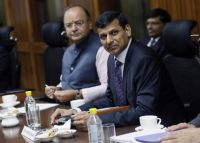
At last, the RBI has came out with a rate cut; though it is a paltry 25 basis point which will not compel a price leader like the SBI to make an interest rate cut.
RBI’s reversal of its policy is late but not surprising. Most of the central banks have already launched easy monetary policy through rate cuts for the last one year.
Despite the decline in inflation to the acceptable low levels, the RBI’s adamant stand has made people lost interest in the activities of the central bank. On the other, that of the government was watched with expectations.
Government led administrative and economic reforms have travelled much distance with the new government.
Many institutions like the World Bank also enhanced GDP forecast for India mainly because of a reform oriented government.
What is the factor which encouraged the RBI to make the rate cut this time? Firstly, Governor Raghuram Rajan has pointed out that demand weakening has taken place. Understandably, this demand weakening in the country is due to continuous high policy rate. The RBI can influence inflation only by reducing demand.
Secondly, the RBI has published its Inflation Expectations Survey of Households for December 2014 on top of the monetary policy release (in its website). According to the Governor, inflation expectations for December 2014 shows short term and long term decline in inflation expectations for the first time since September 2009. This explanation is tailored to give some objectivity to the new rate cut decision.
Similarly, the governor puts conditions in the form of government action on various fronts like- fiscal consolidation, supply promotion, and infrastructure enhancement to drive future rate cuts.











